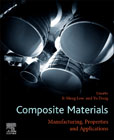
In contrast to monolithic materials such as metals, polymers or ceramics, a composite material consists of two or more physically and/or chemically distinct phases, well-tailored or uniformly distributed for secondary phase as fillers/reinforcements within a matrix. As a result, a composite material usually has characteristics that are not depicted by any of its components in isolation. Composite materials have been well developed to meet the challenges of high-performing material properties targeting engineering and structural applications. The mechanical properties of a composite material are mainly dictated by the type, size, morphology, and content of the reinforcements as well as the nature of the matrix. For instance, in a fibre-reinforced composite, its properties are dependent upon the fibre content, length of individual fibres, fibre orientation and strength fibre-matrix interfacial bonding and fibre distribution. The ability of composite materials to absorb stresses and dissipate strain energy is vastly superior to that of other materials such as polymers and ceramics, and thus they offer engineers many mechanical, thermal, chemical and damage-tolerance advantages with limited drawbacks such as brittleness. A material that can absorb mechanical vibrations, and yet remain stiff and lightweight, should be employed for additional applications comprising precision machine tools, quiet, vibration-free machinery and transportation equipment, industrial robots, and low-density armour. Other potential uses include automobile and aircraft engine components, rocket engine nozzles, aircraft brakes, heating-elements, and racing car brake pads and discs. There has been an enormous amount of research papers published on composite materials over the past decade, but there have been rapid advances in this field of research in recent years in terms of the nature of fibre reinforcement, unique properties, novel micro/nanostructures, and specific new-generation applications. Composite Materials: Manufacturing, Properties and Applications presents a comprehensive review of the current-status and future directions, latest technologies and innovative work challenges and opportunities for composite materials. The chapters present latest advances and comprehensive coverage of the types, design, fabrication, modelling, properties and applications from conventional composite materials to advanced composites such as nanocomposites, self-healing and smart composites. The book targets researchers of advanced composite materials and ceramics, students of materials science and engineering at the postgraduate level, as well as material engineers and scientists working in industrial R& D sectors for composite material manufacturing. Comprehensive coverage of the material types, design, fabrication, modelling, properties and applications from conventional composite materials to advanced composites such as nanocomposites, self-healing and smart compositesFeatures latest advances in terms of mechanical properties and other material parameters which are essential for designers and engineers in the composite and composite reinforcement manufacturing industry, as well as all those with an academic research interest in the subjectOffers a good platform for end users to refer to the latest technologies and topics fitting into specific applications and specific methods to tackle the manufacturing or material processing issues in relation to different types of composite materials INDICE: Design and Manufacture 1. Advanced fibre-reinforced composites 2. High-performance polymer composites 3. Laminated composites 4. Inorganic polymer composites 5. Self-healing, self-sensing, smart polymer composites 6. Advanced green composites 7. Biodegradable and biocompatible polymer composites 8. Cementitious Composites 9. Nanocomposites Properties 10. Mechanical and physical properties of composite materials 11. Creep, fatigue and ageing resistance in composite structures 12. Toughening mechanisms in composite materials 13. Interphase and interfacial properties in composite materials 14. Failure analysis in composite materials 15. Durability and life prediction 16. Modelling of damage processes in composite materials Applications 17. Composites in lightweight constructions 18. Composites in aircraft structures 19. Composites in construction 20. Composites for rehabilitation, strengthening, retrofit and repair 21. Composites for ballistic and military applications 22. Composites for use as sensors and actuators 23. Composites for use in high temperature environments 24. Composites in energy applications (e.g. wind turbine blades)
- ISBN: 978-0-12-820512-9
- Editorial: Elsevier
- Encuadernacion: Rústica
- Páginas: 690
- Fecha Publicación: 01/07/2021
- Nº Volúmenes: 1
- Idioma: Inglés
